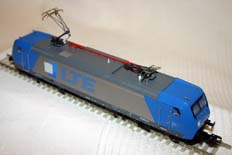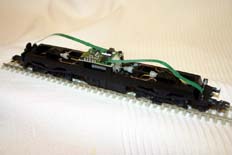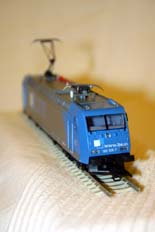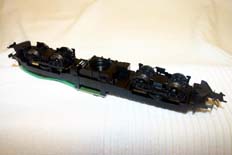
Here we go with another one of our DCC-focussed reviews. Unusually, however, this time we're looking at a model locomotive with an in-built multi-protocol decoder: Trix' BR185 electric loco.

Here we go with another one of our DCC-focussed reviews. Unusually, however, this time we're looking at a model locomotive with an in-built multi-protocol decoder: Trix' BR185 electric loco.
The loco was bought by me to run on the new 'Son of Prutz' being built for exhibition. The focus is on modern Austrian practice and with the two main exponents of the project doing quite well for the OBB locos and stock it's down to the guest operators to bring the interesting stuff.

And the Trix BR 185 is certainly interesting. For a start it's all metal. It has all wheel drive, two traction tyres and a centrally-mounted can motor. And although it's got a decoder the layout it was going to run on is resolutely analogue. That doesn't mean that we should necessarily ignore the performance on DCC; indeed that's the prime focus of this review. I don't have Selectrix equipment to test that functionality so I'm afraid that particular protocol won't be covered here.
It's useful to be able to look at a current version of a loco with a factory-fitted decoder. we've not had a huge amount of success with earlier gernerations; Dave stripped the decoder out of his Broadway 2-8-0, replacing it with a Zimo. And my Roco Austrian BR310 will have to be completely re-wired and a new decoder fitted before I'll be happy with its running on either digital or analogue.
I started by putting the loco on a rolling road for fifteen minutes in each direction, being driven on an analogue controller at about 3/4 throttle. After that the first set of tests I did were on analogue. The reference controller is my KPC zero-feedback unit with running being conducted on the test track - Peco Code 75 track.
To my surprise the running on analogue control is actually very good. Maybe not quite up to the standards you'd expect dedicated non-DCC fitted loco, but certainly good enough for normal use. To be perfectly honest the control is a little 'abrupt' at very slow speeds, but it's a minor criticism as this can be tempered with careful operation of the controller. It certainly runs smoothly and with nothing more than a slight buzzing noise from the decoder while it does so. As expected the lights aren't quite constant, but pretty much what you'd expect from a modern model.

And on DCC? Well I tested the loco on the same track as for the analogue test. But in this example the Lenz Compact was used to drive the loco. There's some useful functionality in the decoder; as expected f0 switches the lights on and off and f4 switches the loco into low speed ('switching') speed range. It'll even support DC braking - but you have to turn CV29, Bit2 off. The loco was run on both 28 and 128 speed steps.
And the running on DCC is superb. As expected it's quieter and smoother than the running on analogue. Setting it to run on 128 speed steps does give a useful edge in performance when accelerating and decelerating. I can't say that the absolute slow speed running is as good as I could achieve with a fully configured decoder, but it's certainly acceptable. By acceptable I mean it's the sort of running that you'd expect out of a good mid-price decoder installed straight into a normal analogue loco. And with the shunting button (f4) engaged the drive is very smooth and controllable at low speed - probably the first time I've seen this type of function employed successfully.
A little educated guess work would lead me to believe that the decoder may well use a sub-set of ESU's technology. Certainly ESU and Märklin have tied up in producing their current DCC console controllers. The ESU LokPilot decoders also have, unusually, a multi-prototcol capability. For me at least it seems too much of a coincidence. The fact that the BR185 runs well on analogue, as ESU-fitted locos do, is the final clincher.
For the price of the model you wouldn't expect a fully featured decoder. And of course, you don't get one. But it does have some useful CVs, though not many of them:
| CV# | Description |
|---|---|
| 1 | Short Address |
| 3 | Acceleration rate |
| 4 | Deceleration rate |
| 5 | Maximum speed |
| 17 | Extended address part 1 |
| 18 | Extended address part 2 |
| 29 | Main configuration data: This controls direction, 14 or 28/128 speed steps, DCC (only) operation and long/short addressing |
| 49 | Pulse width for motor control |
| 50 | Rule variant (no; I don't know what this is either!) |
| 51 | Second configuration data: This controls motor directionality, headlight directionality and track polarity reversal (the latter for use on analogue control I presume) |

But what about the rest of the model? Well it looks like a BR185. The die-cast body adds useful weight which will be good for both haulage and electrical pick-up. The pantographs look useable, but I'm still likely to fit a set of Roco ones as they're the standard employed on the layout.
The finish of the body shell is superb; no obvious flash or mould lines, crisp colour seperation lines, a dense sprayed paint finish and very clear inscriptions. As befits a budget model, not all the handrails are seperate. The coupling hook and brake pipes are moulded into the buffer beam. The coupler pockets aren't on close-coupling guides and I'm not wholly convinced about the shape of the snowplough or sandboxes. In fact there's a bit of the underframe detailing that comes across as a bit basic.
Whilst on the subject of 'a bit basic' the loco has a set of fairly unlovely yellow headlights and no tail lights. Admittedly I'm not fussed as this loco is going to spend it's entire life hauling heavy trains; prototypically the tail lights wouldn't be lit anyway.
To be fair though detailing this loco doesn't require much time or effort and is well worth it. You can see how I tackled it on the LTE BR185 page.

However you look at it, the Trix BR185 represents stunning value for money. Even if you went through replacing all the parts that were considered 'iffy', straightening the detail out as you went it'd still have very positive comparisons for cost, time and effort to either the Piko or Roco models. And the best bit is the price - around £70-75 in the UK, they're frequently available in Germany for around EU80, that's not much more than £50 at the time of writing!
In summary then: It's a bargain...
And I'm intrigued by the possibilities offered by that speaker-shaped cut out in the bottom of the chassis - is there a fully featured, sound equipped version waiting in the wings?